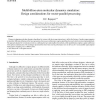Free Online Productivity Tools
i2Speak
i2Symbol
i2OCR
iTex2Img
iWeb2Print
iWeb2Shot
i2Type
iPdf2Split
iPdf2Merge
i2Bopomofo
i2Arabic
i2Style
i2Image
i2PDF
iLatex2Rtf
Sci2ools
CPHYSICS
2006
2006
Multibillion-atom molecular dynamics simulation: Design considerations for vector-parallel processing
Progress in adapting molecular dynamics algorithms for systems with short-range interactions to utilize the features of modern supercomputers is described. Efficient utilization of the latest generation of processor architectures requires algorithms that can be both vectorized and parallelized. The approach adopted for vectorization involves combining the layer and neighbor-list methods, while parallelization employs spatial subdivision with explicit communication. The techniques presented here have been used in performance tests on the Cray X1 vector-parallel supercomputer with systems containing over 12 billion atoms. 2005 Elsevier B.V. All rights reserved. PACS: 02.70.Ns
| Added | 11 Dec 2010 |
| Updated | 11 Dec 2010 |
| Type | Journal |
| Year | 2006 |
| Where | CPHYSICS |
| Authors | D. C. Rapaport |
Comments (0)

